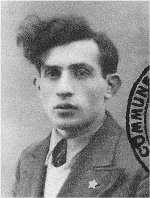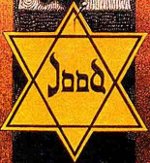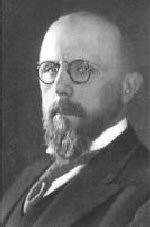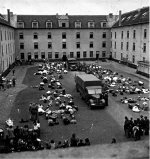Introduction
After the British and German troops consecutively passed through Okegem in May 1940 (sub-municipality of Ninove, Oost-Vlaanderen, Belgium) it seemed that this place wouldn’t play a big role in the progress of war. In Okegem, like in every other municipality, personal drama’s happened: prisoners of war and employees who were sent to Germany for forced labor, escaped young men in the South of France, the daily attempts to make a living, occasional passages of German soldiers... And yet remarkable things happened that only few people were aware of...
One day we stumbled upon an information telling us that in 1942 there were 40 to 50 Jews in Okegem in employment, in particular at the former factory of Patrice de Schepper. If this is true, what should we think of it? Was it a sort of an economical collaboration by De Schepper or a reckless plan to let a large number of Jews go into hiding? We decided to try and find the missing pieces of this forgotten episode in the history of Okegem...
Definitielijst
- collaboration
- Cooperation of the people with the occupying forces, more generally spoken the term for individuals who cooperate with the occupying force is collaborator.
- Jews
- Middle Eastern people with own religion that lived in Palestine. They distinguished themselves by their strong monotheism and the strict observance of the Law and tradition. During World War 2 the Jewish people were ruthlessly persecuted and annihilated by the German Nazis. . An estimated 6,000,000 Jews were exterminated.
Images
The persecution of Jews in Belgium
In 1942 the persecution of Jews in Belgium came into high gear. Since the beginning of the war Jewish people had already been treated as second-class citizens, but at that time there were no mass arrests or raids. However, all kinds of regulations made their lives miserable. One of these regulations was a mandatory registration of Jews since the 28th of October 1940. Keeping these (municipal) registers was entrusted to the Judenrat (Jewish Council or the AJB) that served as a contact between the Nazi occupant and the Jewish people in Belgium. The AJB was hoping to protect its citizens from the worse. In reality its accurate administrative work served as the perfect means for Germans to organize systematic arrests and deportations starting in the summer of 1942. In the years 1940-42 various decrees were issued to gradually close the net around Jews.
On the 6th of March a new decree was issued introducing mandatory labor for all Jews. Theoretically, these decrees were targeted at so-called "antisocial" elements. From the Nazi point of view it was logical that the Jewish people were eligible for this. On the 27th of May 1942 all Jews were obliged to wear a Star of David. These anti-Jewish regulations matched the Nazi policy of mandatory labor. On the 11th of June the "legal" framework of this policy was completed. Officially the Jews were to be put to work following a medical examination. They would be sent to work in the coal mines of Charleroi and Liège, in small and large companies in Antwerp and Brussels or in the large labor camps in northern France (in order to build the Atlantic Wall) and the east of the Reich. Several thousands of men reported to the Dossin barracks in Mechelen (Samellager Mecheln) completely unaware of any risks. From there they were deported to Auschwitz. Many Jews, however, became suspicious and tried to evade the mandatory labor. The local authorities and the AJB helped them with logistics. This is, where the story of the Okegem Jews begins...
Definitielijst
- Jews
- Middle Eastern people with own religion that lived in Palestine. They distinguished themselves by their strong monotheism and the strict observance of the Law and tradition. During World War 2 the Jewish people were ruthlessly persecuted and annihilated by the German Nazis. . An estimated 6,000,000 Jews were exterminated.
- Nazi
- Abbreviation of a national socialist.
Images
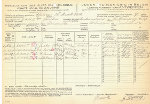 On November 21, 1941, the Jewish Council is established by the Nazis in Belgium, officially to bettter help the Jews, in reality a measure enabling the Nazis to exert better control over the Jewish community Source: http://www.pienternet.be/..
On November 21, 1941, the Jewish Council is established by the Nazis in Belgium, officially to bettter help the Jews, in reality a measure enabling the Nazis to exert better control over the Jewish community Source: http://www.pienternet.be/..The main characters
The mandatory labor rule was the result of an agreement between Patrice de Schepper and Meyer Tabakman, a Jew from Brussels. The municipal administration of Okegem knew about it and approved it. At that time the members of the war administration were Jozef de Roose (mayor), Jozef Debbaut and Frederik van der Speeten (aldermen). We don't exactly know how they were involved in this case. Although before 1940 they were known as members of the Daensist party for their Flemish-mindedness, nobody would tell they showed an exaggerated (or at least proven) collaborative zeal during the war. Contemporaries described De Roose as somebody who put the well-being of the citizens of Okegem first. Perhaps the municipal administration only noted the intention of Patrice de Schepper to employ Jews on his terrain. The only thing required was, that the Jewish workers would follow the municipal regulations and would not mix with the rest of the population. The latter was completely in accordance with German decrees (on the 8th of May they issued a decree to the effect that Jewish workers had to work separately from the "Aryan personnel").
The second protagonist is Patrice de Schepper (1889-1978). Although this man lived for decades in Okegem and owned the biggest company in the municipality, we still don't know much about him. Born in Pamel, De Schepper was the younger brother of Jozef de Schepper, who in 1913, together with Philemon van der Kelen and Gustaaf Borginon started a company at Fontein street. The company was called The Denderboer (the Dender is a river flowing past the village of Okegem. Translator's note) and produced (chemical) fertilizers. Afterwards they switched to the production of matches followed by another swap. Before 1940 they focused on industrial lace-work production (the company name was changed to Dentelles Lux). After the death of Jozef de Schepper, Patrice continued the work during the war with Maurice and Alfred van der Kelen, sons of Philemon. However, the day-to-day management of the company was in the hands of Patrice who went to live in a stately house next to the church.
De Schepper was one of the notables in the village, and yet he remained an enigmatic figure, who didn't participate in the politics of the municipality and events in social life. His personal archive and the company archive of Dentelles Lux seem to have gotten lost, so it's hard to say which role he played in our story. Neither do we know which role he played during World War Two. And yet the "50 Jews" shed a new light on this Okegem industrialist. Was he really somebody who cared for the fate of Jewish people or was he simply looking for the cheap labor?
The fact that De Schepper continued his work in the company and even exported goods to Germany was not proof of his German sympathies. Most Belgian companies just kept working during the war. This decision was a result of the so-called 'Galopindoctrine', a statement by some top industrialists (1940) who reached an agreement that the Belgian business would continue its production during the war. Not only was it the way to save the country from economical collapse, it would help to avoid the deportation of the workers to the east and also to save the country's food supply. According to the Galopindoctrine the trade with the occupant was inevitable, under the condition that no weapons and ammunition would be exported. The line between an economic collaboration and the "policy of the lesser evil" is very thin.
Moreover the research tells us that the trade with Nazi Germany in the textile sector prevailed over trade in other industrial sectors. Many clothing companies received orders from the German army. In the case of Dentelles Lux it's difficult to consider the export of curtain lace tapes, carpets and lingerie as an act of collaboration. However, the Okegem company must have maintained very good contacts with the German market. Patrice de Schepper knew Germany quite well and in 1934 he recruited the German mechanic Erich Quambusch. This Quambusch came to live with his family in Okegem and for many years he worked as a team boss at Dentelles Lux.
The third important character in this story is Meyer Tabakman, the man who came up with the (hiding and escape) plan at De Schepper's. Tabakman (1912-1944) was born in Siedlce in Poland and arrived in Brussels in 1927. There he married Rajzla Kibel who was also originally from Poland. The young Jew was a trader or a hawker (the descriptions in sources vary). Anyway it is certain that he continued doing the same job after the war began.
Definitielijst
- collaboration
- Cooperation of the people with the occupying forces, more generally spoken the term for individuals who cooperate with the occupying force is collaborator.
- Jews
- Middle Eastern people with own religion that lived in Palestine. They distinguished themselves by their strong monotheism and the strict observance of the Law and tradition. During World War 2 the Jewish people were ruthlessly persecuted and annihilated by the German Nazis. . An estimated 6,000,000 Jews were exterminated.
- Nazi
- Abbreviation of a national socialist.
Images
 The Denderboer was renamed Dentelles Lux, producing industrial lace-work. Jews were employed here. Source: Heemkring Okegem.
The Denderboer was renamed Dentelles Lux, producing industrial lace-work. Jews were employed here. Source: Heemkring Okegem.Mandatory employment of Jews
Meyer Tabakman, however, was more than just a trader. The persecution of the Jews drove him into the Brussels resistance. We know that in February 1942 he was recruited by the Mouvement National Belge, a Belgian conservative resistance movement that was mainly active in Brussels. His commercial activities were at the same time a cover for the spreading of illicit leaflets (La Voix des Belges, Le Flambeau, Notre Parole), assisting members of the resistance and Jews in hiding, making and distributing of false identity cards etc.
Tabakman had many connections in Brussels, and was a man with multiple faces. He was not only active within the Belgian royalist resistance, his name also appeared within the group of left wing Zionist youths. In these environments there was a very strong idea that Jewish youngsters, after a thorough ideological and agricultural education in model farms, had to be prepared for a life as a settler in what would once be called the promised land of Israel. For example, we know that a "model farm" was also established in Bomal (province of Walloon Brabant) in 1942. Following the wording of the Okegem municipal administration they decided to set up (at least officially) such a model farm d’un terrain non-cultivé de deux hectars env. dans le but de le cultiver par le groupe des cultivateurs en question (on a non-cultivated terrain of about 23,919.8 square yards in order to have it cultivated by the group in question) in our municipality.
Of course, behind this Jewish-ideological façade a whole system was functioning, helping as many Jews as possible to escape from arrests and mandatory labor. Through June and July German authorities still condoned the "voluntary" employments at companies and projects of public interest. The summer of 1942 became the turning point in the "Jewish question". The occupant believed, the Jews had to disappear from the streets and had to do mandatory labor. The only question was, where to employ them. At that time German authorities still didn't pay much attention to projects like the one in Okegem.
The occupant counted on the cooperation of Belgian municipal authorities in implementation of anti-Jewish measures. Though there is a lot of controversy about this case among historians, a recent research shows that the local authorities were not over eager to participate in the persecution of the Jews. But this was not the case in other municipalities: in Antwerp, for example, the city authorities and the police showed more enthusiasm than elsewhere to implement anti-Jewish measures. In Brussels, the municipal authorities were often inventive to let Jews escape arrests. For example, in July 1942, the authorities of Oudergem saved their Jewish residents from deportation by putting them to work at the municipal cemetery. Partly due to the great influence of the AJB in Brussels, the capital put up resistance to the persecution of Jews. The Judenrat used all the influence it had on German authorities to save its people from the antisemitic measures. Within the AJB on the 9th of July a Jewish Service for Probation and Placement (JSPP) was founded to employ Jews in existing factories, in newly set up workshops for exclusively Jewish workers or even in agricultural centers that had yet to be organized. This last category, as mentioned before, was put into practice in Bomal and therefore had to be followed in Okegem. The approval of municipal administration of Okegem to let several Jews work on its territory was issued one day after the JSPP was established. All these changes had to happen quickly because at that time the net around the Jews started to close.
Definitielijst
- Jews
- Middle Eastern people with own religion that lived in Palestine. They distinguished themselves by their strong monotheism and the strict observance of the Law and tradition. During World War 2 the Jewish people were ruthlessly persecuted and annihilated by the German Nazis. . An estimated 6,000,000 Jews were exterminated.
- persecution of the Jews
- "Judenverfolgung", action imposed by the Nazis to make life hard for the Jews, to actively persecute them and even annihilate them.
- resistance
- Resistance against the enemy. Often also with armed resources.
Images
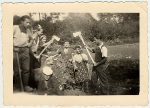 Jewish youngsters just felled a tree at the school of agriculture at La Ramée Source: USHMM.
Jewish youngsters just felled a tree at the school of agriculture at La Ramée Source: USHMM. The Oudegem cemetery where Jews were employed in 1942 Source: http://www.urba.be/Rues/nl_rues_v.htm.
The Oudegem cemetery where Jews were employed in 1942 Source: http://www.urba.be/Rues/nl_rues_v.htm.Hiding in Okegem
Meyer Tabakman played a central part in searching for the working and hiding places for the Jews. He inherited this commitment from his father Szrul-Israël who was also active within the Jewish community in Brussels. Meyer used his contacts within the AJB, the Zionist movement and the Belgian resistance to bring lots of Jews to safety in the beginning of July. After all, there were still a lot of loopholes in the net. An AJB employee could stay safely out of the claws of the German police. For example, it is known that the AJB received permission from the German Arbeitsamt of Brussels on the 4th of July 1942 to exempt 56 Jews from mandatory employment. This applied to the staff and members of the organization's management. It is possible that all or some of them were the people for whom Meyer Tabakman found accommodation in the following days. The accommodation was approved by the municipality of Okegem. After that together with four other colleagues (Turyer, Waysglus, Zaidman and another Grul (Szrul?) Tabakman, probably his father) on the 12th of July he founded an association for "exploitation of a field as big as 2 hectares on the territory of Okegem". A few dozen Jews could get to work there. This way the entire initiative would get a legal framework.
There is no doubt that Meyer had a plan to let a group of Jews go into hiding in Okegem. And still there are some questions left. Did the Jews really get to work and if yes, in what circumstances? How big was the group, where did they stay and for how long? As Jews were not allowed to make contact with others, nobody would be aware of their hiding in Okegem. An inquiry of people who experienced the war consciously wasn't giving any results for a long time. But in an interview with Frans van de Perre en Maria de Strooper the subject suddenly turned to the war. Frans could remember that through July and August of 1942 a group of Jews was staying in the side wing of the parental house.
The house of his father Odilon was situated at the end of the Bruggeweg. Given the forced anonymity of the Jews in the municipality, this house was a great choice. It is a dead end street and the house would let the workers reach the factory grounds of Patrice de Schepper (about 200 meters down the road) easily and unseen. Frans confirmed that in the beginning of July 1942 de Schepper asked Odilon van de Perre to give shelter to a group of Jewish workers. The industrialist stressed that nobody in Okegem might come to know anything about it. According to Frans it was about the group of (just) 20 men, at most 30 years old, whom he would only see in the evening when they would come to sleep in the attic of the side wing. The composition of the group and the number of its members changed regularly, which makes us guess that the "model farm" of Okegem was no more than a stopover in a long escape route, a passage to (safer) places. The young men didn't seek any contact with the Van de Perre family, they didn't ask for food because reportedly they had their own. If necessary, they could make themselves understood in a few words in Dutch, but otherwise they would speak a strange language, probably Yiddish (90% of the Jewish population in Belgium during the war came from Eastern Europe where people talked to each other in a mixture of Yiddish and German).
Frans only saw the men cleaning the territory of the factory, it seems that they were not allowed to enter the factory workshops. He could remember that they weren't used to work with agricultural equipment, (which confirms the statement that they came from the city). We don't know how long exactly they stayed in Okegem, but according to Frans it wasn't longer that one or two months. Suddenly they disappeared. This might have happened in August 1942. This is perfectly understandable since at that moment the intensity of the raids increased and the first deportations in Belgium to the extermination camps started.
We probably won't get to know all the details of Jews in hiding in Okegem. Were they arrested in Okegem or were they able to escape in time? Have they survived the war? A wide-scale arrest in Okegem could be possible, but it wouldn't go unnoticed. Presumably, they were sent away from Brussels and left Okegem in a hurry. Chances are that they, like many others, ran into the persecutors shortly afterwards and were deported to the Dossin barracks in Mechelen.
Definitielijst
- Jews
- Middle Eastern people with own religion that lived in Palestine. They distinguished themselves by their strong monotheism and the strict observance of the Law and tradition. During World War 2 the Jewish people were ruthlessly persecuted and annihilated by the German Nazis. . An estimated 6,000,000 Jews were exterminated.
- resistance
- Resistance against the enemy. Often also with armed resources.
Images
 The center of Okegem, a small village on the river Dender in east Flanders Source: Heemkring Okegem.
The center of Okegem, a small village on the river Dender in east Flanders Source: Heemkring Okegem.The Oskar Schindler of Okegem?
What the reason was for Patrice de Schepper to employ the Jews remains a mystery. He died childless and according to our information he left no data. Moreover, it's unlikely that he ever put anything about this whole affair on paper. And yet we will try to make a guess.
As we mentioned before, he didn't really engage in contact with other Okegem citizens. He was and remained a Pamelnian who recruited his workers elsewhere (mainly from Impegem) and for many things he often went to Brussels. There it was, where he met Meyer Tabakman, a trader with many contacts within the Jewish community. Tabakman was well aware of the danger that threatened himself and other Jews. So he would make use of his business contacts with De Schepper (both of them traded in the textile sector). The director of the Okegem factory, in a mixture of compassion and a need for cheap labor, saw the risks the temporary employment of several dozen Jews brought with it. He was perfectly aware of the game rules the occupant created through June and July 1942. He would work under the protection of the local municipal administration, which in their turn stressed that this case might not become an object of gossip. When the deportations started in August, the Jews were probably urged to leave their hiding place in Okegem. This really was necessary because the Germans were officially aware of the Jewish presence. It could be possible that the war mayor de Roose warned them that an arrest was imminent. Anyway, the Jews left Okegem in the end of August.
The time after the war ended was for De Schepper "business as usual". Therefore Odilon van de Perre thought he could use left over equipment and wood after the Jews left. Probably he should have discussed it with De Schepper first, because the latter claimed all the material for himself.
Anyway, it was certain that working in Dentelles Lux was a guarantee to not be sent to Germany for mandatory labor. Maria de Strooper (the wife of Frans van de Perre) could confirm this fact, because when she was young, she was working at "the factory" temporarily. After De Schepper fired her she was arrested by the Feldgendarmerie and sent to Germany for mandatory labor (after spending two weeks in prison in Sint-Gillis). De Schepper continued his industrial activities during the war, which made him suspect in the eyes of some of the Okegem inhabitants. They thought of him as of a collaborator with the occupant. After the war they painted a swastika on his house.
Reportedly they made their apologies afterwards and his name was cleaned by the municipality. It is certain that he was never officially accused of an economical collaboration with Germans. So we can see him as the "Oskar Schindler of Okegem" for the time being.
Definitielijst
- collaboration
- Cooperation of the people with the occupying forces, more generally spoken the term for individuals who cooperate with the occupying force is collaborator.
- Jews
- Middle Eastern people with own religion that lived in Palestine. They distinguished themselves by their strong monotheism and the strict observance of the Law and tradition. During World War 2 the Jewish people were ruthlessly persecuted and annihilated by the German Nazis. . An estimated 6,000,000 Jews were exterminated.
- swastika
- Equilateral cross, symbol of Nazi-Germany.
Images
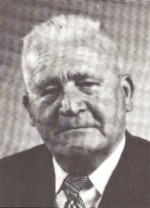 Wartime Mayor Josef de Roose Source: Heemkring Okegem.
Wartime Mayor Josef de Roose Source: Heemkring Okegem.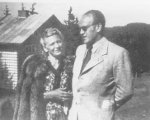 The real Oskar Schindler, with his wife Emilie Source: http://www.holocaustresearchproject.org.
The real Oskar Schindler, with his wife Emilie Source: http://www.holocaustresearchproject.org.And what about Meyer Tabakman?
What about Meyer Tabakman then? Well, his life went on like in a movie (sadly, without a happy ending). In January 1943 he was arrested and sent to the Dossin barracks in Mechelen. His name was on the list of the "19th transport" but he managed to escape (from Mechelen, or may be, he jumped out of the riding train, we are not sure). In April 1943 he got caught again and was placed on the notorious 20th convoy. This convoy is well known because of an escape action of the resistance which saved more than 200 people.
The rest of the year Tabakman spent in hiding in Brussels, where he continued his work in the resistance. In December 1943 he got caught again in Vorst. After a new passage in Mechelen, he was put on the 23rd convoy on the 15th of January 1944. His journey to Auschwitz was fatal, since nothing else was heard from him anymore.
Definitielijst
- resistance
- Resistance against the enemy. Often also with armed resources.
Information
- Article by:
- Patrick Praet
- Translated by:
- Liza de Groot
- Published on:
- 01-03-2019
- Feedback?
- Send it!
Sources
- NEFORS, P., Industriële collaboratie in Belgie, Van Halewijck, Leuven, 2008.
- SCHREIBER, J-PH. & VAN DOORSLAER, R., De curatoren van het getto, Lannoo, Tielt, 2004.
- VAN DOORSLAER, R. e.a., Gewillig België’, Meulenhoff/Manteau, 2007.
- This article was published as "Schindler in Okegem? A forgotten episode from World War Two" in Announcements of Heemkring Okegem 2011, nr. 2, p. 25-37.
- VAN DER SPEETEN, Okegem en Okegemnaars in Wereldoorlog II, in Mededelingen Heemkring Okegem, 15, 1990, blz. 33-47, 60-72; 16, 1991, blz. 1-14; 18, 1993, blz. 45-53; 19, 1994, p. 73-86; 20, 1995, blz. 41-76.
- P. PRAET, Mei 1940. Ontsnapt aan de dood te Okegem, in Mededelingen Heemkring Okegem, 28, 2003, blz. 97-105.
- J. VAN DER SPEETEN, Verdwenen nijverheidsbedrijven te Okegem. De fabriek ‘De Denderboer’ en Nervia, in Mededelingen Heemkring Okegem, 8, 1983, nr. 3, p. 121-149.
- ARCHIEF YAD VASHEM JERUZALEM, 029/1.
- ARCHIEF YAD VASHEM JERUZALEM, 0.29/4. Het gaat om een getypt document gedateerd op 12 juli 1942.
- Interview with Frans van de Perre en Maria De Strooper, 5 november 2010.
- The dossier of Meyer Tabakman can be found in de DIENST VOOR OORLOGSSLACHTOFFERS, nr. 44336/1662.
